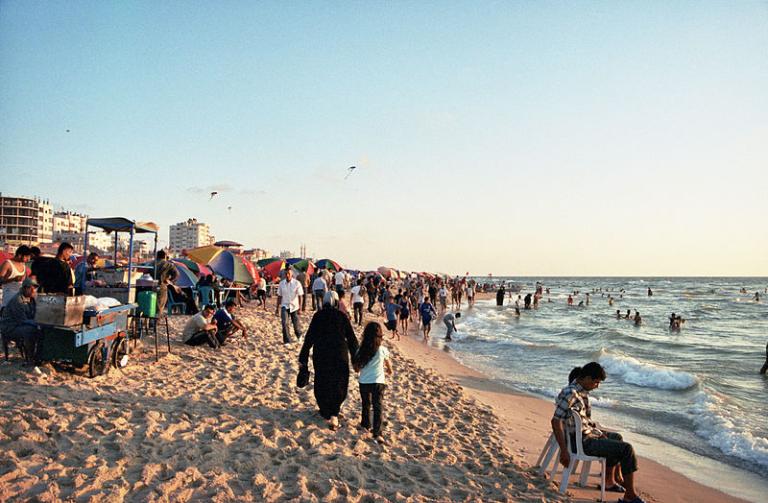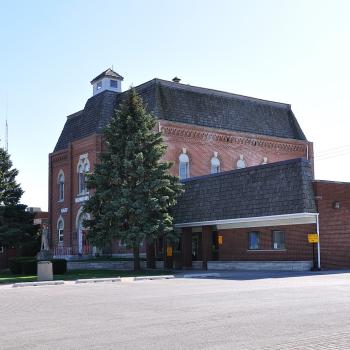
Is what’s going on in Gaza at the moment a “protest”? No. Protestors march around yelling chants in order for those whom they’re angry at to see their anger and their numbers.
Is it a “riot”? No. That’s uncontrolled chaos with the goal of causing destruction, either truly for no reason at all, or as a means of causing harm to some disfavored group (Korean shopkeepers, for instance).
Is it a military incursion? It’s a challenge to use this vocabulary when there is no organized military leading a charge, and when the attackers seem to have no realistic expectation of breaching the barrier, but, rather, have the objective of creating sympathy by deaths of some among their number.
Is it a mass suicide endeavor? That would seem to require that those involved, not just the planners, have suicide in mind.
Should we just be vague and call it an “action” at the border? No, the Germans used that label for their Aktions already.
I am coming to believe that the lack of a label for what they’re up to, is a real problem. Since we can’t adequately describe it, we fall back on words that fail to appropriately capture what’s going on. It’s not far removed from newspaper headlines like “train kills man” which turn out to be suicide-by-train but suggest to the casual reader that the engineer / train line is somehow at fault. And so, too, we have headlines such as “Israelis kill more than 50 Palestinians in Gaza protests, health officials say,” in Monday’s Washington Post, which gives the impression that Israel was somehow the instigator.
Here’s some text from that article:
Some young men brought knives and fence cutters. At a gathering point east of Gaza City, organizers urged protesters over loudspeakers to burst through the fence, telling them Israeli soldiers were fleeing their positions, even as they were reinforcing them. . . .
A truck rolled past carrying young men chanting: “To Jerusalem we go with millions of martyrs” and “Death rather than humiliation.”
Drones dropped canisters of tear gas, sending crowds fleeing. Other drones dropped leaflets that urged demonstrators to say back from the fence. . . .
While some said they would abide by official calls to keep the demonstrations peaceful, others talked about their enthusiasm to break into Israel and wreak havoc.
“We are excited to storm and get inside,” said 23-year-old Mohammed Mansoura. When asked what he would do inside Israel, he said, “Whatever is possible, to kill, throw stones.”
Two other young men carried large knives and said they wanted to kill Jews on the other side of the fence.
The Israeli military brought two extra brigades to the Gaza border in preparation for the demonstrations and added additional “defense lines” in an effort to prevent any mass invasion into Israeli communities near the border.
The military said at least 40,000 people protested in 13 places along the fence — more than twice as many locations as in past weeks of protest.
Other reports say that Hamas itself is claiming 50 of the 62 dead as Hamas militants, that Gazans used Facebook to encourage young men to come to the border prepared to kidnap Israelis, and that rioters damaged a border crossing and gas line used to provide materials and heat to the people of Gaza. And, as a reminder, this has nothing to do with the opening of the US embassy, but rather with the 70th anniversary of the founding of the state of Israel; it was merely that the US embassy’s opening was timed to coincide with these celebrations.
New York Times columnist Michelle Goldberg writes alongside a chorus of others, that the response of the Israeli army is “disproportionate” because those attempting to cross the border don’t “pose an imminent threat.” But what is Israel to do? Wait until individual Gazans rush Israeli soldiers? Or chase after them if they rush into the neighboring villages? Is there some sort of obligation to wait for these men, who have already proclaimed their intention to kill, to start stabbing, before they can respond? And before you say, “yes, they should no more be shot than an American police officer should shoot someone,” consider that this is an attack, even if it’s one we don’t have the right vocabulary and concepts for.
Now, as a side note, I’ll admit that it does seem a bit peculiar that Israel has built a literal wall to prevent incursions from the West Bank area, but that the border with Gaza appears to consist of extensive barbed-wire fencing. It stands to reason, after all, that a barbed-wire fence at least gives the illusion of being breach-able, in a way that a concrete barrier wouldn’t. But, on the other hand, Hamas’s response up to this point has been tunnelling, not wire-cutting.
And, as a further reminder, no, I don’t have an answer on the larger question, and, in particular, Gaza seems to be particularly ****ed.
UPDATE: here’s a link to share with you, “The Unfixable Tragedy of Gaza.” Can they govern themselves? Not likely. Does someone else want to govern them? No. Can they just all be located? Nope. Hence, the “unfixable” of the headline.
Ideally, since it is cut off physically from the West Bank, Gaza would become an independent, self-sufficient nation-state of its own — a goal that Hamas claims to desire. But its small size, poverty, dysfunction, and radicalized population all make that a dim prospect for the foreseeable future.
Image: image: https://commons.wikimedia.org/wiki/File%3AGaza_Beach.jpg; By Gus at Dutch Wikipedia (Transferred from nl.wikipedia to Commons.) [Public domain], via Wikimedia Commons












